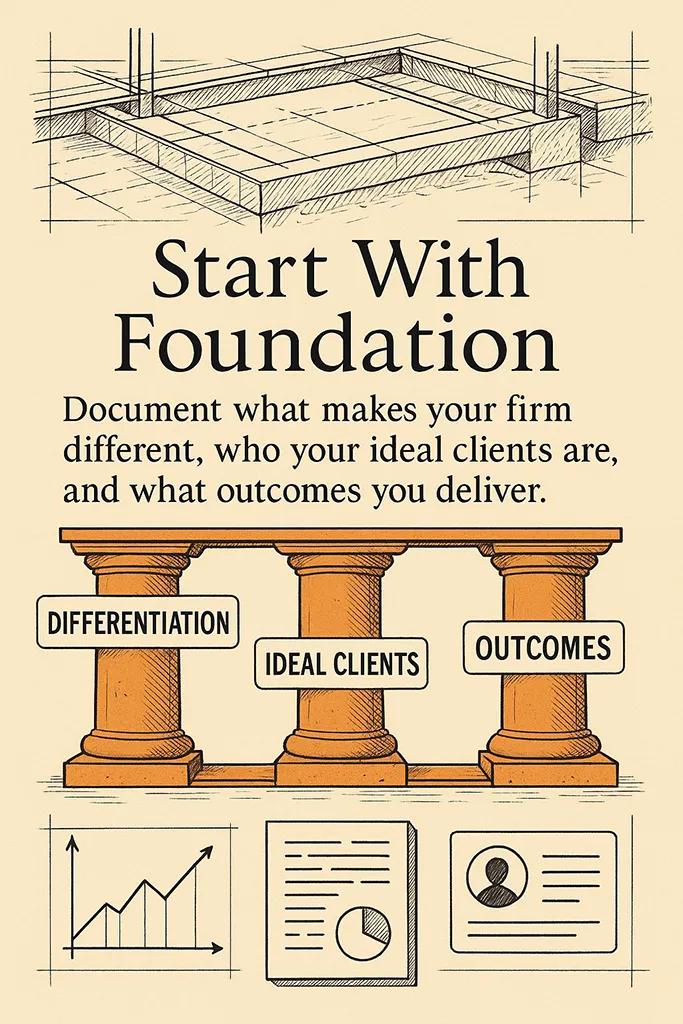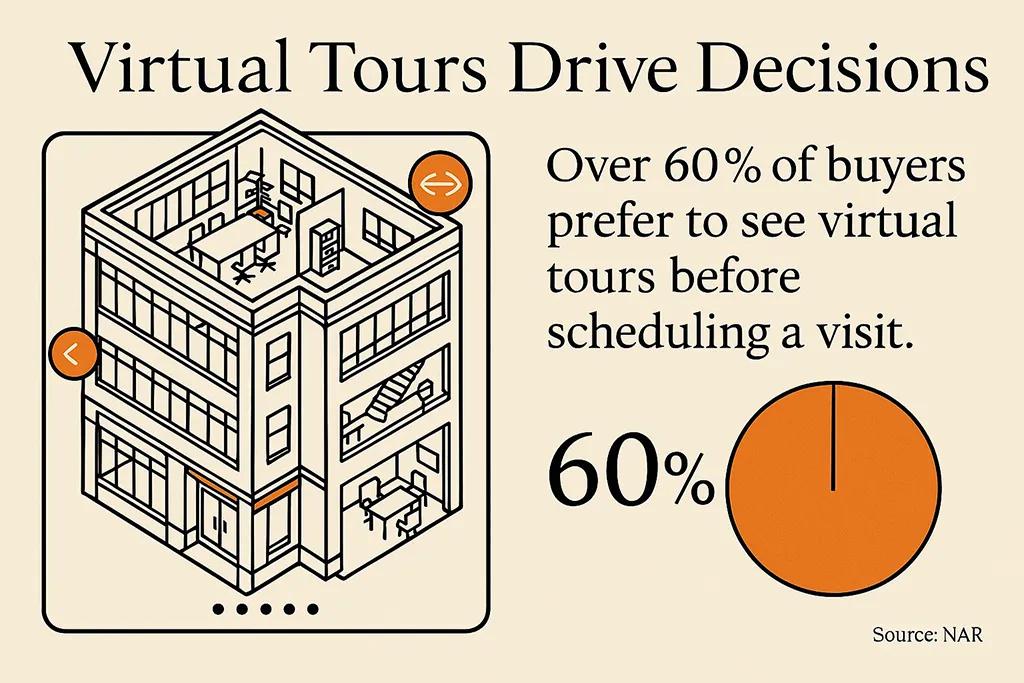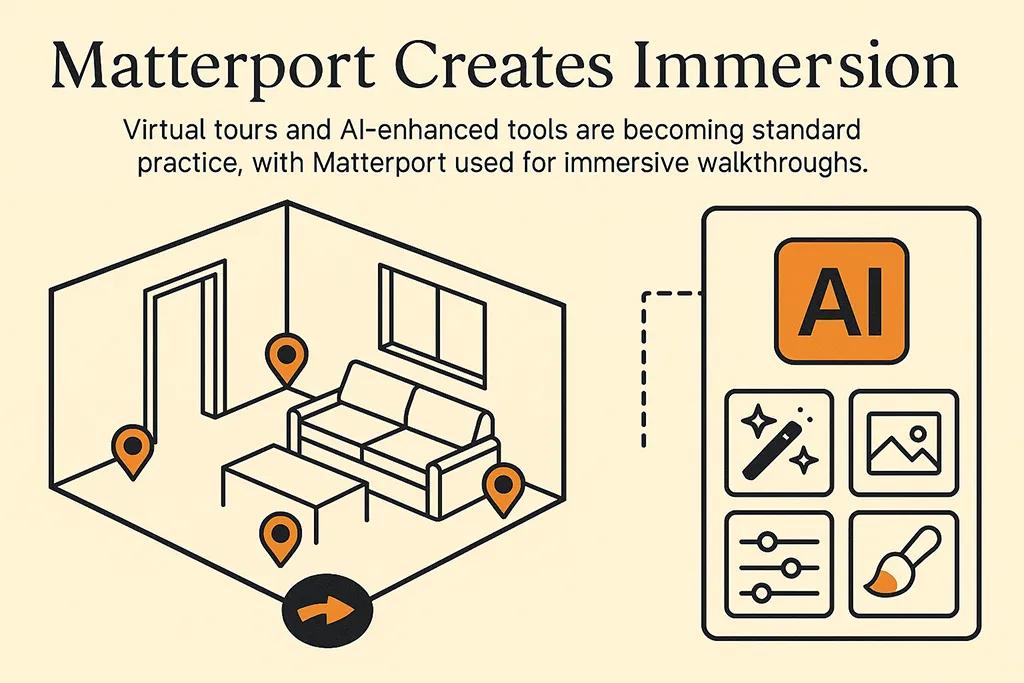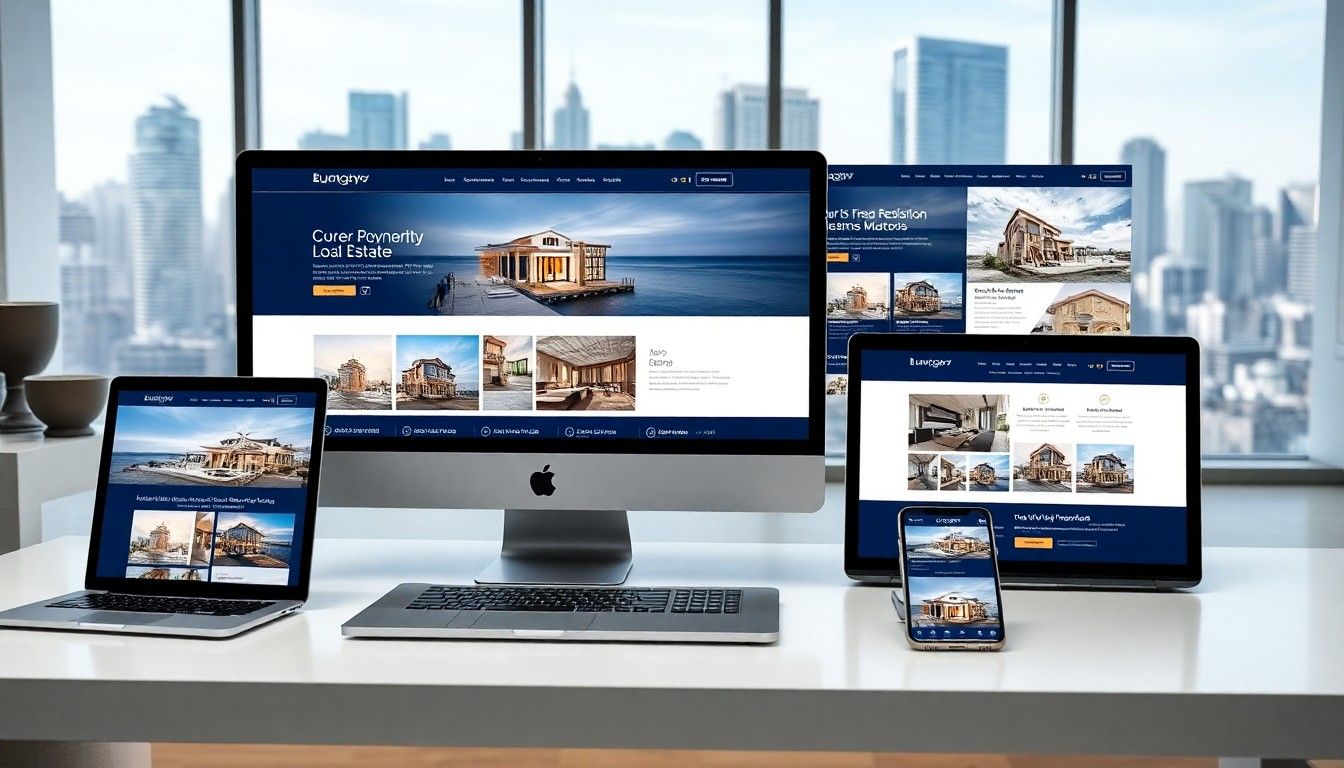Commercial Real Estate Branding

Your commercial real estate firm looks exactly like every other firm in your market. Same stock photos of office buildings. Same corporate blue color scheme. Same "professional service excellence" messaging that says absolutely nothing.
Here's what actually makes a difference: buyers often make decisions based on what they find through Google searches, social media, and referrals. Your brand shows up in all three places. Either it stands out or it blends into the background noise.
The commercial real estate firms that thrive aren't just selling properties. They're selling confidence, expertise, and results through every visual element and message they put out there. That confidence starts with a brand that actually reflects what makes your firm unique.
We'll show you how to build commercial real estate branding that differentiates your firm from day one. You'll learn to identify what makes your approach different, translate that difference into visual and messaging elements, and deploy those elements across every client touchpoint. By the end, you'll have a clear roadmap for branding that attracts your ideal clients and commands premium positioning.
Why Most Commercial Real Estate Branding Falls Flat
Walk through any commercial district and count how many "Premier Commercial Real Estate" signs you see. Check LinkedIn for firms promising "unparalleled expertise" and "client-focused solutions." The language is interchangeable because the thinking behind it is identical.
Most commercial real estate firms approach branding like they approach property listings. They focus on features instead of outcomes. Square footage instead of business growth potential. Location details instead of strategic advantages.
This feature-focused approach creates three major problems that keep firms trapped in commodity positioning:
Generic Messaging That Says Nothing
"Full-service commercial real estate solutions" could describe any firm in any market. These phrases don't help prospects understand what makes your firm different or why they should choose you over the competitor down the street.
Effective branding messages connect your firm's specific strengths to client outcomes. Instead of listing services, they explain results. Instead of highlighting qualifications, they demonstrate value.
Visual Identity Without Strategic Foundation
Many firms start with logo design and color selection before defining what their brand should communicate. This backwards approach creates visually appealing materials that don't support business goals.
Strong commercial real estate brands build visual elements around strategic positioning. The colors, fonts, and imagery all reinforce the same core message about what makes the firm uniquely valuable.
Inconsistent Brand Application
A firm might have professional business cards but a basic website. Polished marketing materials but generic email signatures. High-quality property brochures but no social media presence.
Prospects judge your firm based on every interaction, not just the polished ones. Inconsistent branding suggests inconsistent service delivery, which undermines trust before the first meeting.
These branding gaps create opportunities for firms that get the fundamentals right. When your brand clearly communicates value and maintains that clarity across all touchpoints, you naturally stand out from firms still using generic approaches.

Building Your Brand Foundation Through Market Position
Strong commercial real estate branding starts with understanding exactly where your firm fits in the market and what value you deliver that others don't. This positioning becomes the foundation for every visual and messaging decision.
The most successful firms we work with can explain their market position in one clear sentence. They know their ideal client profile, their unique service approach, and the specific outcomes they deliver better than anyone else.
Define Your Ideal Client Profile
Generic targeting creates generic branding. Firms that try to appeal to everyone end up appealing to no one because their brand can't speak directly to any specific audience's needs.
Start by identifying the 20% of your clients who generate 80% of your revenue and satisfaction. What industries do they represent? What size transactions do they typically need? What challenges do they face that your firm solves particularly well?
Document these patterns in detail. The more specific your ideal client profile, the more targeted and effective your branding can become.
Industry Focus
- Specific Details: Healthcare, Manufacturing, Tech
- Branding Implications: Industry-specific case studies and messaging
Transaction Size
- Specific Details: $2M - $15M properties
- Branding Implications: Mid-market positioning and capability emphasis
Geographic Scope
- Specific Details: Regional expansion companies
- Branding Implications: Market knowledge and growth expertise focus
Decision Timeline
- Specific Details: 6-18 month planning cycles
- Branding Implications: Long-term partnership messaging
Identify Your Unique Service Approach
Every commercial real estate firm helps clients buy, sell, or lease properties. The differentiation comes from how you approach that process and what additional value you provide.
Some firms excel at complex multi-market transactions. Others specialize in specific property types or industries. Some focus on speed and efficiency, while others emphasize strategic consultation and long-term planning.
Your unique approach should align with your ideal client's specific needs. A firm targeting fast-growing tech companies might emphasize agility and scalability planning. A firm serving established manufacturers might focus on operational efficiency and supply chain considerations.
Articulate Your Value Proposition
Your value proposition connects your unique approach to specific client outcomes. It answers the question: "What do clients get from working with us that they can't get elsewhere?"
Strong value propositions are specific and measurable. Instead of "better service," they might promise "20% faster lease negotiations through our proprietary market database." Instead of "industry expertise," they might offer "average 15% cost savings through our healthcare facility optimization process."
Test your value proposition by asking current clients why they chose your firm and what results they've achieved. Their language often provides the clearest articulation of your unique value.
Once you've defined your ideal client, unique approach, and specific value proposition, you have the strategic foundation needed to build brand elements that actually differentiate your firm in the market.
Document what makes your firm different, who your ideal clients are, and the outcomes you deliver.

Creating Visual Identity That Communicates Your Position
With your strategic foundation in place, you can now develop visual brand elements that reinforce your market position rather than work against it. Every color, font, and imagery choice should support the same core message about what makes your firm uniquely valuable.
The most effective commercial real estate brands use visual elements strategically. They don't just look professional - they communicate specific messages about the firm's approach, expertise, and client focus.
Color Psychology for Commercial Real Estate
Color choices influence how prospects perceive your firm before they read a single word of your messaging. Different colors communicate different attributes, and your palette should align with your positioning strategy.
Traditional commercial real estate blue suggests stability and trust, which works well for firms positioning as established market leaders. Deep greens communicate growth and prosperity, fitting for firms focused on investment strategy. Modern grays and blacks can position a firm as sophisticated and contemporary.
Consider what attributes matter most to your ideal clients. A firm targeting innovative tech companies might choose more modern colors, while a firm serving traditional industries might benefit from classic business colors.

Typography That Reflects Your Approach
Font selection affects readability and brand perception across all your marketing materials. Clean, modern fonts work well for firms emphasizing efficiency and innovation. Traditional serif fonts can reinforce messages about experience and stability.
Choose fonts that remain readable across all applications, from business cards to building signage. Your primary font should work well for headlines and body text, with a complementary font for accent use.
Consistency matters more than creativity here. Using the same fonts across all materials creates a cohesive brand experience that builds recognition over time.
Photography and Imagery Strategy
Most commercial real estate firms use the same stock photos of glass office buildings and handshakes. This generic imagery does nothing to differentiate your firm or communicate your specific value.
Effective imagery shows your work in context. Instead of generic building photos, use images of specific properties you've helped clients acquire or develop. Instead of stock handshake photos, use pictures of actual client meetings or project completions.
Professional real estate photography and graphic design can transform how prospects perceive your properties and your firm's capabilities.
Property Photos
- Generic Approach: Standard exterior shots
- Strategic Approach: Context showing business operations and potential
Team Photos
- Generic Approach: Formal corporate headshots
- Strategic Approach: Natural photos showing expertise in action
Process Images
- Generic Approach: Generic handshake stock photos
- Strategic Approach: Actual client interactions and project milestones
Market Data
- Generic Approach: Text-heavy reports
- Strategic Approach: Visual infographics highlighting key insights
Your visual identity should make your firm immediately recognizable while communicating the specific attributes that matter most to your target clients. When prospects see your materials, they should understand both what you do and how you're different from other options.

Digital Brand Implementation for Maximum Impact
Your digital presence determines most first impressions in commercial real estate. Over 60% of buyers prefer to see virtual tours before scheduling a visit, and they're researching your firm online long before they contact you directly.
Over 60% of buyers prefer virtual tours before scheduling a visit.
Effective digital brand implementation goes beyond having a professional website. It creates a cohesive experience across every digital touchpoint that reinforces your positioning and makes it easy for prospects to understand your value.
Website Design That Converts Prospects
Your website serves as your firm's digital headquarters. It should immediately communicate who you serve, what makes you different, and what results clients can expect.
The most effective commercial real estate websites focus on client outcomes rather than firm credentials. They show specific examples of successful transactions, include detailed case studies, and make it easy for prospects to understand the firm's process.
Navigation should reflect how prospects think about their needs, not how you organize your services internally. Instead of "Services" and "About Us" pages, consider structure like "Growing Companies," "Relocating Operations," and "Investment Opportunities."
Include AI-driven marketing features like automated chatbots for lead capture, which can manage up to 80% of initial inquiries while maintaining your brand voice and positioning.
AI-driven chatbots can manage up to 80% of initial inquiries.
Content Strategy for Authority Building
Regular content creation establishes your firm as a market authority while providing value to prospects before they're ready to engage directly. Focus content on the specific challenges your ideal clients face.
Market analysis, regulatory updates, and industry trend reports work well for most commercial real estate firms. The key is making content specific to your target audience rather than creating generic real estate information.
A firm serving healthcare clients might create content about healthcare facility regulations and design trends. A firm focused on industrial properties might analyze supply chain impacts on warehouse demand.
Effective messaging strategies help ensure your content resonates with your specific audience rather than trying to appeal to everyone.
Social Media and Digital Advertising
Commercial real estate prospects use LinkedIn, industry publications, and search engines to research potential partners. Your brand should appear consistently across these channels.
LinkedIn works particularly well for commercial real estate because decision-makers actively use it for professional research. Share market insights, project completions, and thought leadership content that demonstrates your expertise.
Digital advertising allows precise targeting based on industry, company size, and geographic location. This precision makes it possible to put your brand message in front of ideal prospects when they're actively researching commercial real estate options.
- LinkedIn advertising targeting specific industries and job titles
- Google Ads for location and property-type specific searches
- Industry publication advertising in relevant trade magazines
- Email marketing to prospects and referral partners
- Content marketing through industry blogs and publications
Digital brand consistency across all these channels reinforces your positioning and builds recognition among prospects who might see your firm's name multiple times before they're ready to engage.
Advanced Brand Differentiation Techniques
Once you have strong brand fundamentals in place, advanced techniques can create even more distance between your firm and competitors. These strategies work particularly well for firms in competitive markets where basic branding isn't enough to stand out.
The most successful commercial real estate firms combine multiple differentiation techniques to create positioning that's almost impossible for competitors to replicate.
Specialized Technology Integration
Virtual tours and AI-enhanced tools are becoming standard practice, with tools like Matterport being used for immersive property walkthroughs. Firms that adopt and integrate these technologies effectively can position themselves as forward-thinking partners.
Virtual tours and AI-enhanced tools are becoming standard, with Matterport enabling immersive walkthroughs.
Technology differentiation works best when it directly benefits your ideal clients. A firm serving companies with multiple locations might invest in portfolio management software. A firm focused on development projects might use advanced 3D visualization tools.
The key is choosing technology that enhances your unique service approach rather than adopting technology for its own sake. Technology should make your firm's specific value proposition more compelling and easier to deliver.
Partnership and Network Positioning
Strategic partnerships can differentiate your firm by expanding the value you can deliver to clients. Partnerships with architects, contractors, financing specialists, or legal experts allow you to position your firm as a comprehensive resource.
These partnerships become particularly valuable when they align with your ideal client's needs. A firm targeting growing tech companies might partner with specialists in flexible workspace design. A firm serving healthcare clients might partner with medical facility architects and equipment specialists.
Brand your partnerships strategically. Instead of just listing partner companies, explain how these relationships deliver specific value to your clients.
Thought Leadership and Market Expertise
Establishing your firm's leaders as industry experts creates differentiation that's difficult for competitors to replicate quickly. This approach works particularly well for firms with deep experience in specific markets or property types.
Thought leadership can take many forms: speaking at industry conferences, contributing to trade publications, hosting educational webinars, or publishing detailed market research.
The most effective differentiation strategies often combine expertise demonstration with practical value delivery to prospects and clients.
Technology Integration
- Best For: Firms serving tech-forward clients
- Implementation Timeline: 3-6 months
Strategic Partnerships
- Best For: Firms wanting to expand service scope
- Implementation Timeline: 6-12 months
Thought Leadership
- Best For: Firms with deep market expertise
- Implementation Timeline: 12-24 months
Specialized Certification
- Best For: Firms in regulated industries
- Implementation Timeline: 6-18 months
The most effective advanced differentiation techniques align with your firm's existing strengths and your ideal client's specific needs. Choose techniques that reinforce your core positioning rather than diluting your brand message.
Measuring Brand Impact and Adjusting Strategy
Brand building in commercial real estate requires measurement and ongoing refinement. Unlike direct response marketing, branding creates value over time through increased recognition, improved positioning, and stronger client relationships.
The most successful firms track both quantitative metrics and qualitative feedback to understand how their branding efforts impact business results.
Key Performance Indicators for Brand Success
Brand measurement in commercial real estate focuses on leading indicators that predict future business growth. These metrics help you understand whether your brand is successfully differentiating your firm and attracting ideal clients.
Website traffic quality often matters more than quantity. Track which types of companies visit your site, how long they stay, and which content they engage with most. This data reveals whether your brand messaging is attracting your ideal client profile.
Referral patterns provide insight into how market participants perceive your firm. Track referral sources, referral quality, and the language referral partners use when recommending your firm.
- Qualified lead volume from target client segments
- Average time from first contact to signed agreement
- Premium pricing acceptance rates compared to competitors
- Referral volume and quality from target sources
- Brand recognition in target market surveys
Client Feedback and Brand Perception
Regular client feedback reveals how well your brand aligns with actual service delivery. The strongest brands create expectations that the firm consistently meets or exceeds.
Ask clients why they chose your firm over alternatives. Their responses indicate which brand messages resonate most effectively and which differentiators matter most to your target audience.
Also track how clients describe your firm to others. The language they use often reveals your firm's actual market position, which might differ from your intended positioning.
Competitive Brand Analysis
Monitor how competitors position themselves and adapt their branding strategies. This analysis helps identify opportunities to strengthen your differentiation or adjust your messaging.
Pay attention to new firms entering your market and how they position themselves. New entrants often use branding strategies that challenge established firm approaches.
Track competitor website changes, new service offerings, and marketing messages. This information helps you anticipate market shifts and adjust your brand strategy proactively.
Brand measurement should inform ongoing refinement of your visual identity, messaging, and market positioning. The most effective commercial real estate brands evolve continuously based on market feedback and changing client needs.
Taking Action on Your Brand Development
Commercial real estate branding that truly differentiates your firm requires systematic implementation of the strategies we've covered. Start with the strategic foundation, then build visual elements and digital presence that consistently reinforce your unique position.
The firms that succeed with this approach commit to brand consistency across every client touchpoint. They understand that branding isn't a one-time project but an ongoing process of reinforcing their market position through every interaction.
Begin with a clear assessment of your current brand position. Document what makes your firm different, who your ideal clients are, and what outcomes you deliver better than alternatives. Use this foundation to guide every branding decision moving forward.
Your next step is conducting a brand audit of all existing materials. Identify inconsistencies between your current brand presentation and your intended positioning. Create a timeline for updating materials that don't support your strategic brand direction.
Focus on high-impact opportunities first. Your website, email signatures, and proposal templates touch every prospect interaction. Professional brand design that reflects your firm's expertise can transform how prospects perceive your capabilities.
Focus on high-impact opportunities first: website, email signatures, and proposal templates touch every prospect.
Remember that effective branding requires patience and persistence. The commercial real estate firms with the strongest market positions built their brands consistently over years, not months. Start implementing these strategies now, measure the impact regularly, and refine your approach based on market feedback.
Your brand is already communicating something about your firm. The question is whether it's communicating what you want it to communicate, to the right audience, in a way that drives the business results you need.



